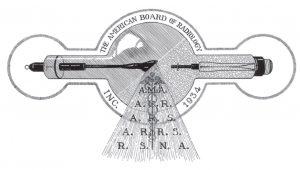Our History
Last verified on December 18, 2023
In his 1932 presidential address to the American College of Radiology (ACR), Dr. Arthur C. Christie, a Washington, DC, radiologist, stated the desirability of creating an organization—a new specialty board—to provide examinations for certifying physicians as specialists in the discipline of radiology. It would be called the American Board of Radiology.
After two years of discussion among representatives of the four major national radiology societies—American Roentgen Ray Society (ARRS), Radiological Society of North America (RSNA), American Radium Society (ARS), and American College of Radiology (ACR)—the ABR was incorporated in January 1934 in Washington, D.C. The AMA Section on Radiology was the fifth sponsor.
At the time of the ABR’s founding, bylaws were adopted and resolutions were established to ensure the ABR’s proper functioning. The primary charge of the Board was to provide examinations and certify physicians who sought recognition as radiologists.
Since 1934, the field of radiology has expanded dramatically. To allow physicians to “acquire and maintain” the appropriate knowledge and skills for their practice domains, radiation oncology and diagnostic radiology developed separate training programs, and both lengthened residencies to four years. In 1947, the Board also began to examine and certify candidates for recognition as medical physicists. In 2012, the ABMS approved the Interventional Radiology/Diagnostic Radiology (IR/DR) primary certificate to recognize IR as a unique medical specialty.
New sponsors, including the American Association of Physicists in Medicine (AAPM), the American Society for Radiation Oncology (ASTRO), the Association of University Radiologists (AUR), and the Society for Interventional Radiology (SIR) were added over the years. As the field of radiology has developed, various certificates also have been added and deleted to accommodate the changes in practice and the adoption of new technology (see certificate information).
To ensure that its diplomates keep pace with ongoing changes in the knowledge, skill, and understanding essential to practice, the ABR began to issue time-limited certificates in 1994 for pediatric radiology and vascular and interventional radiology. Time-limited certificates were offered for neuroradiology in 1995 and for nuclear radiology in 1999. The ABR completed the transition to offering only time-limited certificates in 2002.
In 2015, the ABR completed the process of phasing out its initial qualifying “written” and oral diagnostic radiology examinations and implementing new computer-based diagnostic radiology initial certification exams, known as the Core and Certifying Exams.
In 2019, the ABR introduced Online Longitudinal Assessment (OLA), a progressive assessment that could be used as a replacement for the proctored Continuing Certification Exam. OLA is aligned with the other three parts of Continuing Certification (MOC) that remain the same—Part 1: state licensure; Part 2: CME and self-assessment; and Part 4: participation in practice quality improvement activities.
The ABR also maintains open working relationships with the Accreditation Council for Graduate Medical Education (ACGME) and the Residency Review Committees for Radiology and Radiation Oncology. The Board continues active interaction with its sponsoring organizations, other medical specialty boards, specialty societies, medical societies, residency program directors, chairs of hospital departments, its diplomates, and the entire radiologic community.



